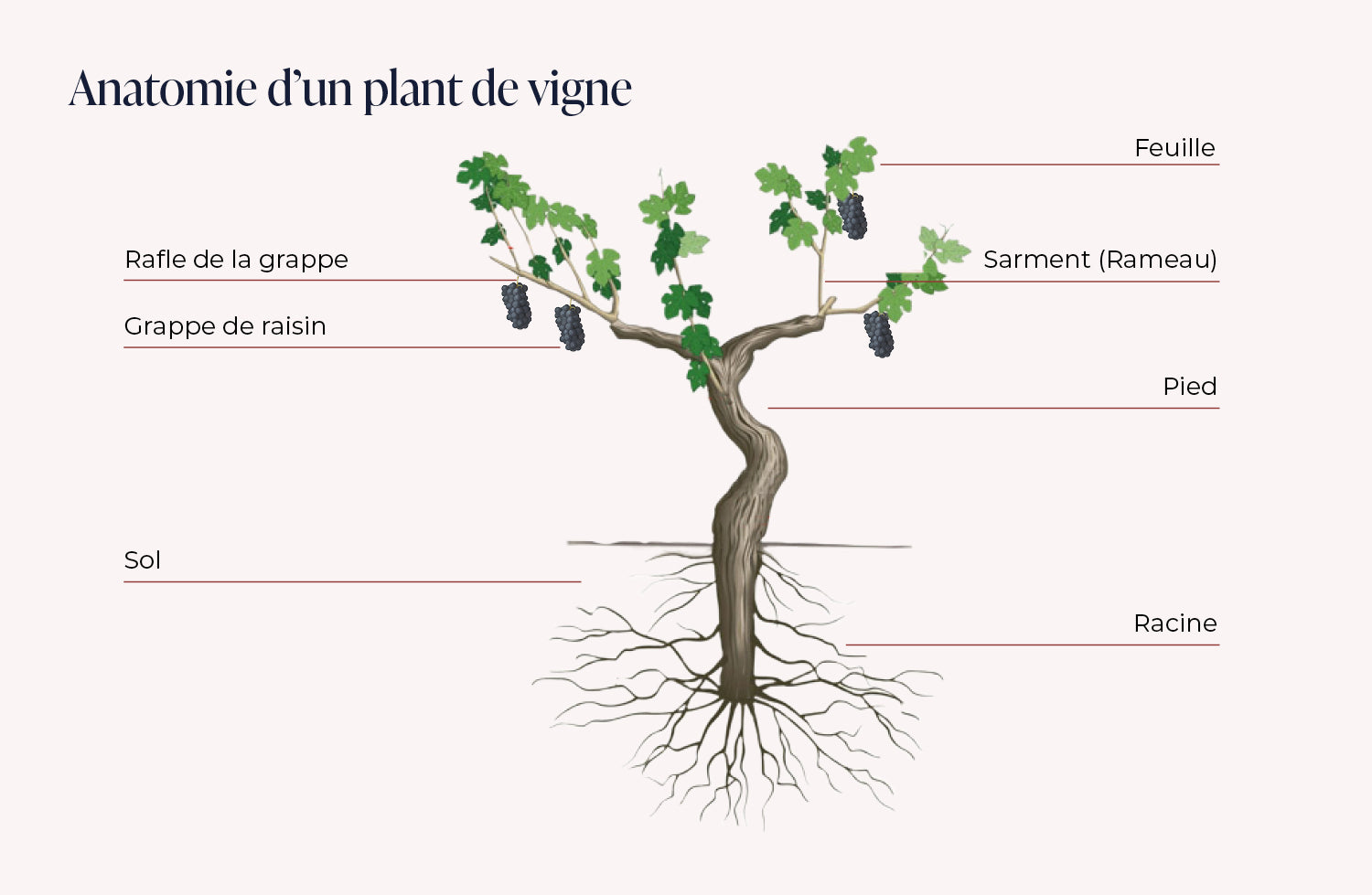Vine
The vine, or Vitis, is a climbing shrub in the Vitaceae botanical family, also known as Vitaceae or Ampelidaceae. This plant produces bunches of grapes - its fruit - of which certain varieties from the genus Vitis vinifera L. are grown in vineyards to make wine.
Anatomy of a vine plant

- Roots
- Vine
- Bunch of grapes
- Leaves
- Vine shoot
- Soil
The different varieties of vine
Botanists have identified around 80 species of Vitis (over 21 000 varieties of vines !), divided into 2 sub-types.
| Euvitis | Muscadinia |
|---|---|
| Eurasian Euvitis: one species, Vitis vinifera L., which alone produces almost all the world's wineAmerican Euvitis: more than 20 species East Asian Euvitis: a minority in viticulture, comprising 55 species | 3 species including Muscadinia rotundifolia, cultivated in North America |
| Euvitis | Eurasian Euvitis: one species, Vitis vinifera L., which alone produces almost all the world's wineAmerican Euvitis: more than 20 species East Asian Euvitis: a minority in viticulture, comprising 55 species |
| Muscadinia | 3 species including Muscadinia rotundifolia, cultivated in North America |
A brief history of vines and wine
Vines and gastronomy... an affinity that has spanned the ages! First domesticated in Central Asia, this plant was later cultivated on the shores of the Mediterranean by the Greeks. It was the Romans who imported the vine to Italy, Spain and France... The first vineyard was established around 600 BC in Massalia, the ancient city of Marseille. Now the world's second largest wine producer, France also owes the spread of wine-growing to Christianity, wine being the symbol of the Eucharist. But how can the diversity of the vine genome be explained?
- Over the centuries, man has multiplied the grape varieties by selecting and cutting those with the tastiest grapes. These vines were transported and marketed across the globe, often in the form of seeds.
- At the end of the 19th century, phylloxera (the vine aphid) invaded and devastated the vineyards of Europe. This phylloxera crisis led to the planting of vines derived from crosses between Eurasian Euvitis and certain American Euvitis. The vines Vitis berlandieri, Vitis riparia and Vitis rupestris have since been used as rootstocks for Vitis vinifera.
- Finally, the natural genetic mutations of this small tree have increased the diversity of grape varieties.
Vines and winegroing, a real art!
The maintenance of a vineyard, an area where vines are grown (viticulture), is based on the natural cycle of this plant.
| Month | Vine | Vineyard operations |
|---|---|---|
| September / october | End of ripening of the white or red grapes | Monitoring the ripening of the grapes. Manual or technical harvesting |
| November | Beginning of the vine's winter rest period | Preparing for cutting. Shoots to protect them from the cold |
| December/January/February/early March | Winter rest | Vine pruning to optimise grape production |
| End of March/April | Vine awakens budburst: leaves and buds form | Wire trellising to tie vine shoots together |
| May/June | Flowering | Treatment against parasites and diseases. Trimming and bracing of fruit-bearing shoots against wires. Trimming of non-fruit-bearing shoots |
| July | Setting: transformation of flower ovaries into grapes | Treatment and thinning of bunches |
| August | Véraison: grape development and ripening | Treatment and thinning of bunches |
| Month | September / october |
| Vine | End of ripening of the white or red grapes |
| Vineyard operations | Monitoring the ripening of the grapes. Manual or technical harvesting |
| Month | November |
| Vine | Beginning of the vine's winter rest period |
| Vineyard operations | Preparing for cutting. Shoots to protect them from the cold |
| Month | December/January/February/early March |
| Vine | Winter rest |
| Vineyard operations | Vine pruning to optimise grape production |
| Month | End of March/April |
| Vine | Vine awakens budburst: leaves and buds form |
| Vineyard operations | Wire trellising to tie vine shoots together |
| Month | May/June |
| Vine | Flowering |
| Vineyard operations | Treatment against parasites and diseases. Trimming and bracing of fruit-bearing shoots against wires. Trimming of non-fruit-bearing shoots |
| Month | July |
| Vine | Setting: transformation of flower ovaries into grapes |
| Vineyard operations | Treatment and thinning of bunches |
| Month | August |
| Vine | Véraison: grape development and ripening |
| Vineyard operations | Treatment and thinning of bunches |
At the end of this cycle, the new harvest can take place and delight our taste buds with the products of the vine :
- table grapes,
- dried grapes,
- grape juice,
- white, red and rosé wines (produced by vinification)
- brandies,
- grape seed oil,
- wine vinegar,
- jams,
- etc.
